
10 Examples of Biodegradable Plastics for Sustainable Solutions
Overview
Have you ever thought about the impact of plastic on our planet? It’s a big issue, right? Well, the article "10 Examples of Biodegradable Plastics for Sustainable Solutions" dives into some exciting alternatives that can help us tackle this problem. It showcases various types of biodegradable plastics that are not just eco-friendly but also super versatile.
Let’s chat about some of these innovations! You might have heard of:
- Polyhydroxyalkanoates (PHAs)
- Polylactic Acid (PLA)
These materials, along with starch blends, are stepping up to reduce our environmental footprint. Imagine using them in packaging or even in medical devices! It’s all about finding sustainable applications that make a difference.
So, why should we care? Because these biodegradable options can really change the game. They offer a way to enjoy the benefits of plastic without the guilt of harming our environment. Now, let’s talk about how we can all play a part in this shift towards sustainability. Are you ready to explore these alternatives and make a positive impact?
Introduction
Plastic pollution is a big deal these days, right? It’s got everyone buzzing about finding new materials that can help us out without sacrificing quality. Enter biodegradable plastics! These materials are leading the charge, giving us a peek into a future where things can break down naturally, which is a win for the environment.
But as we dive into this topic, you might be asking yourself: Which biodegradable plastics really do the trick? And what cool uses are popping up across different industries? Well, you’re in luck! This article is here to explore ten fascinating examples of biodegradable plastics. Not only do they show off their versatility, but they also shine a light on the challenges and opportunities we face as we move toward a more sustainable future. So, let’s jump in!
Lincoln Plastics: Custom Extrusion Solutions for Biodegradable Plastics
At Lincoln Plastics, we get it—finding the right materials for your projects can be a challenge. That’s why we specialize in custom profile extrusion, focusing on innovative solutions that include examples of biodegradable plastics. With over 15 years in the plastic extrusion game, we’re here to help OEMs and businesses like yours discover sustainable alternatives that truly fit your needs.
So, what do we do? Our expertise lies in crafting custom profile extrusions from materials like:
- polyethylene
- ridged PVC
- flexible PVC
- polypropylene
We’re all about quality and customization, ensuring you receive high-performance, environmentally-friendly materials, which include examples of biodegradable plastics that work for everything from packaging to agricultural applications.
Now, let’s talk about versatility. We offer adaptable manufacturing solutions, including the ability to co-extrude various colors into profiles. Plus, we can produce both standard and custom round profiles. This means you get the flexibility you need to make your projects stand out.
Ready to explore how we can help you? Let’s connect and find the perfect solution together!
Polyhydroxyalkanoates (PHAs): Versatile Biodegradable Plastics for Various Applications
Have you ever thought about the impact of the materials we use every day? Well, polyhydroxyalkanoates (PHAs) are among the examples of biodegradable plastics shaking things up in the world of biodegradable materials. These innovative substances come from microbial fermentation of sugars or lipids, and they’re super versatile! You can find them in everything from eco-friendly packaging to essential medical devices. Plus, recent tech advancements mean we can now engineer PHAs to have specific mechanical properties, making them flexible and durable for various uses. And here’s the kicker: PHAs are great examples of biodegradable plastics that break down naturally, making them a much greener option compared to traditional materials that often contribute to pollution.
Now, let’s talk about some exciting news from 2025! The PHA sector has seen some notable advancements, including a $7 million grant from the U.S. National Science Foundation aimed at developing durable and reusable bioplastics from eco-friendly biomaterials. Researchers have even created films that mimic traditional materials but are compostable. This is a game-changer for tackling the pressing issue of disposable waste, especially for industries searching for examples of biodegradable plastics as sustainable packaging solutions. The demand for PHAs is on the rise, with North America accounting for about 40% of global revenue, thanks to significant investments in biotechnological research and supportive government regulations.
Experts are buzzing about the benefits of PHAs. Their enhanced mechanical properties and versatility make them perfect for a variety of applications, including food packaging and medical devices. By blending different bacterial strains, we can tweak film characteristics like crystallinity and melting point, which boosts their adaptability even more. However, it’s not all smooth sailing; the PHA market does face challenges, like limited production capacity, which could slow down growth. But as the need for eco-friendly materials continues to climb, examples of biodegradable plastics such as PHAs are poised to play a vital role in the future of compostable products. So, what do you think? Are you ready to embrace these sustainable alternatives?
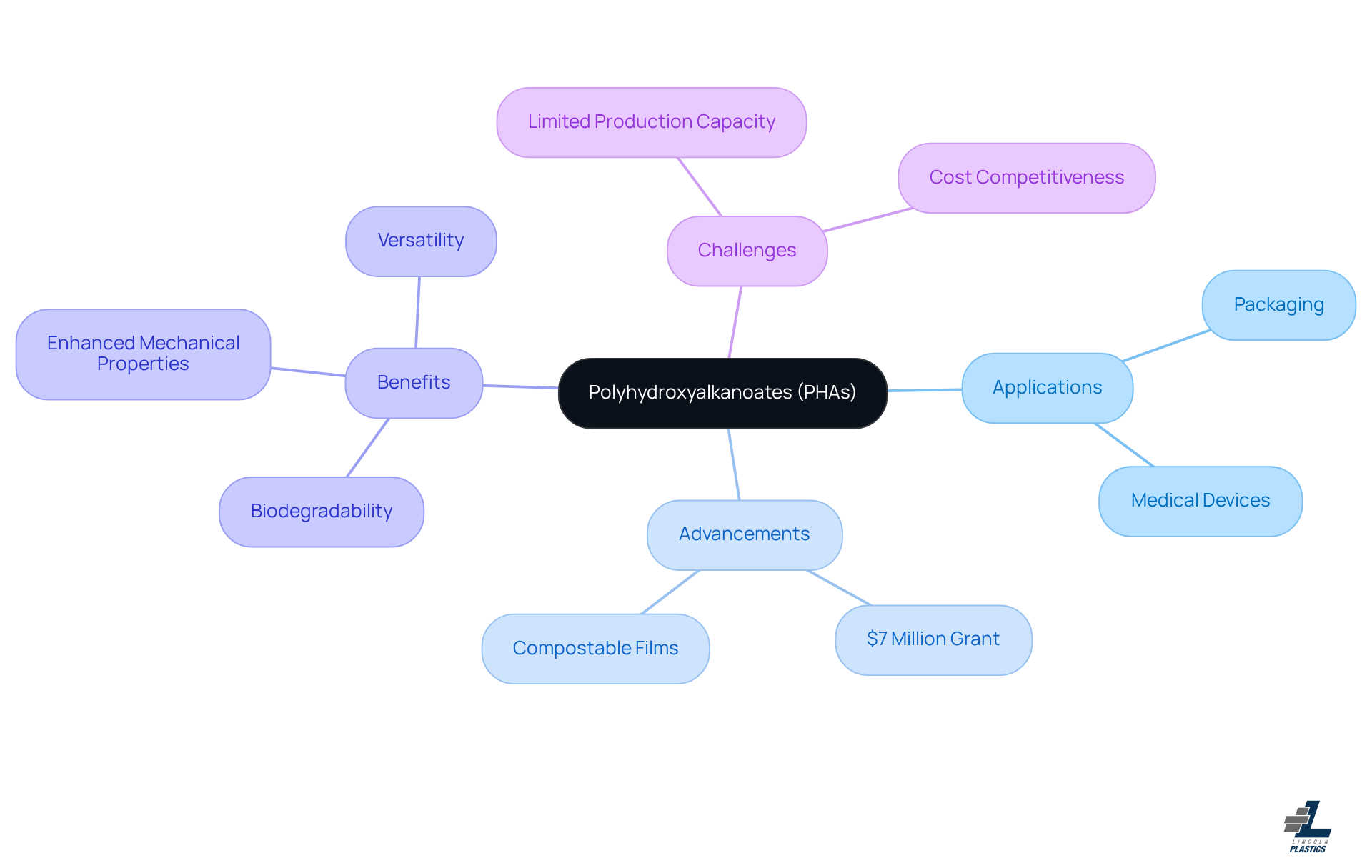
Polylactic Acid (PLA): A Leading Biodegradable Plastic in Packaging
Have you ever thought about the impact of packaging on our planet? It’s a big deal, right? Well, here’s where Polylactic Acid (PLA) comes into play. This compostable polymer is made from renewable resources like corn starch or sugarcane, and it’s shaking things up in the packaging industry.
Why is PLA so popular? For starters, it boasts excellent mechanical properties and serves as one of the examples of biodegradable plastics. You can find it in all sorts of forms—films, containers, and even fibers. It’s like the Swiss Army knife of eco-friendly packaging solutions!
And here’s the kicker: PLA breaks down in industrial composting facilities. That makes it a fantastic sustainable alternative to traditional materials, such as examples of biodegradable plastics. So, if you’re looking to make a positive change in your packaging choices, why not consider PLA? It’s a step towards a greener future!

Starch Blends: Sustainable Biodegradable Plastics from Renewable Resources
Starch blends are making waves in the world of biodegradable materials! By combining starch with other polymers, these blends boost performance and offer a greener alternative to traditional synthetics. Since they come from renewable sources, they’re a win for the environment.
You might be wondering where these blends fit in. Well, their versatility opens the door to all sorts of applications—think packaging, agricultural films, and even disposable products, which are examples of biodegradable plastics. Plus, examples of biodegradable plastics demonstrate their biodegradability and compostability, which help cut down on landfill waste, something we can all get behind, right? With more consumers seeking sustainable options, companies are jumping on board. For example, food producers are increasingly asking for examples of biodegradable plastics in their quest for compostable packaging, showing just how practical these blends can be in reducing our environmental footprint.
Environmental scientists are really pushing for a shift to starch-based materials. Why? Because these blends can significantly lower carbon emissions compared to traditional synthetics. That’s a big deal! The U.S. compostable materials market is projected to grow from about USD 2.34 billion in 2025 to around USD 5.27 billion by 2034, with a solid growth rate of 9.44%. As the demand for eco-friendly materials rises, starch blends are set to play a key role in paving the way for a greener future.
But it’s not all smooth sailing. There are still challenges to tackle, like high production costs and competition with food supply. These hurdles are significant, but with the right focus, we can overcome them together!

Cellulose-Based Plastics: Eco-Friendly Alternatives in Biodegradable Solutions
Have you ever thought about the impact of the materials we use every day? Well, cellulose-derived materials, which come from natural plant fibers, are stepping up as eco-friendly alternatives in our search for sustainable solutions. These materials are excellent examples of biodegradable plastics, and they’re also super versatile! You can turn them into films, coatings, and molded products, making them perfect for packaging and a bunch of other uses. Plus, since they break down naturally, they help reduce our reliance on fossil fuels and support a circular economy.
Now, let’s talk about some exciting developments! In 2025, experts have really highlighted the potential of cellulose materials. For instance, Maksud Rahman, an Assistant Professor of Mechanical and Aerospace Engineering, envisions these strong, multifunctional bacterial cellulose sheets becoming commonplace, replacing traditional materials in various industries. And guess what? Researchers have come up with a scalable way to produce these sheets, boosting their mechanical properties and making them even more appealing for different applications.
You might be wondering how companies are getting involved. Well, big names like Amazon are diving into cellulose-based products, exploring eco-friendly options like bio-based shopping bags made from plant-derived resources. This shift is driven by a growing awareness of the environmental impact of conventional materials, with cellulose-based alternatives and other examples of biodegradable plastics leading the charge toward sustainable choices. As the cellulose bioplastics market continues to expand, it’s projected to grow significantly, with global bioplastics output expected to jump from 2.47 million tons in 2024 to 5.73 million tons in 2029. That’s a clear sign that the demand for packaging that includes examples of biodegradable plastics and beyond is on the rise!
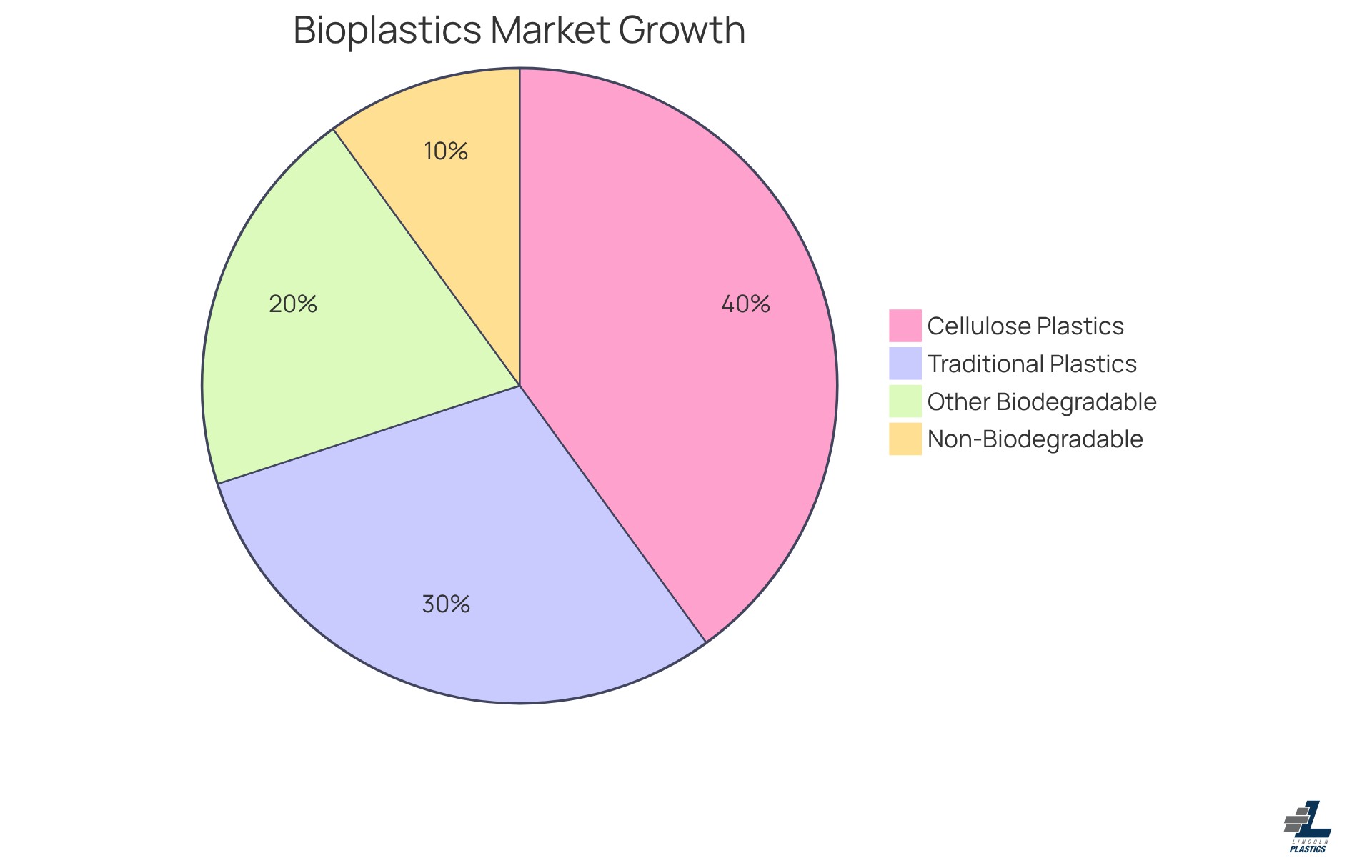
Oxo-Degradable Plastics: Accelerated Breakdown for Improved Waste Management
Oxo-degradable materials are meant to break down faster than traditional plastics when they’re exposed to things like heat and UV light. They have additives that help with oxidation, which leads to fragmentation. Sounds good, right? But here’s the catch: while they might break down quicker, they can create microplastics that are a real headache for our environment.
Research shows that these materials don’t biodegrade safely. Instead, they just break into smaller bits that add to pollution. So, environmentalists are raising a red flag, saying we shouldn’t call them ‘eco-friendly’ unless we can actually collect and recycle them effectively. And get this: even though they claim to degrade quickly, statistics reveal that they can stick around for a long time—some estimates say they might take about two years to break down, all while still being litter.
If you’re a business looking into oxo-degradable options, you’ve got some serious considerations to juggle. You need to weigh the benefits against the potential environmental impacts, especially with stricter regulations coming in 2025. Starting July 15, 2024, there’ll be bans on these materials. Plus, there’s a global inconsistency in how they’re regulated—while they’re banned in Europe, they’re still required in oil-producing countries. That just adds another layer of complexity for decision-makers in the industry.
So, what’s the takeaway? It’s crucial to stay informed and think critically about the materials we choose. Let’s keep the conversation going about how we can make better choices for our planet!
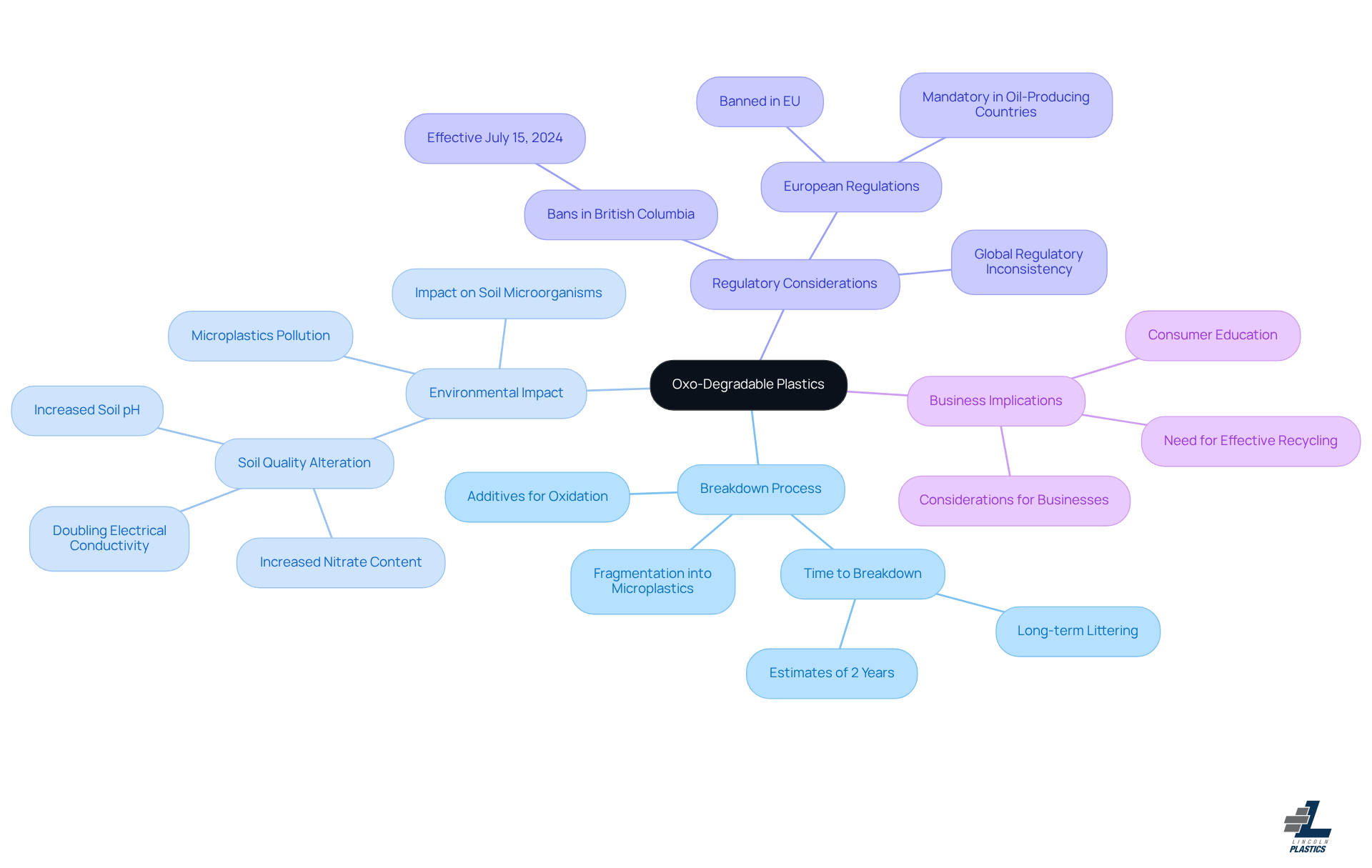
Home Compostable Plastics: Convenient Solutions for Sustainable Waste Management
Home compostable plastics are pretty cool, right? They’re designed to break down nicely in your home composting system, making them a great choice for those of us who care about the planet. These materials turn into organic matter, which is fantastic for soil health, and they don’t leave behind any nasty residues or microplastics. With a growing range of products like compostable bags, food containers, and utensils, it’s easier than ever to make eco-friendly choices in our daily lives. By using these products, we can really cut down on waste and promote better waste management practices.
Now, let’s talk about some exciting innovations! Companies like Ahlstrom are leading the way with their GreenPod Home coffee capsules, made from renewable fibers and certified for home compostability. Did you know that billions of coffee capsules are used worldwide each year? Most of them are made from materials or aluminum that are tough to recycle. But with this new technology, you can toss those used capsules in with your organic waste, helping create a closed-loop waste management system.
And here’s a fun fact: the global compostable packaging market is expected to grow significantly, projected to hit around USD 76.81 billion in 2025 and reach USD 120.14 billion by 2032! This growth is fueled by our increasing demand for eco-friendly packaging and the push against synthetic materials.
Sustainability advocates are really excited about these innovations. They point out that true sustainability comes from systems that work well in our everyday lives, like home composting. By swapping out petroleum-based materials for renewable, compostable fibers, companies can cut emissions and reduce waste. This aligns perfectly with the global shift towards a circular economy. Plus, the new home compostable certification from BPI is a game-changer, helping to clear up any confusion and support the move to a circular bioeconomy. Clear labeling and consumer education are key here!
As more of us focus on being environmentally responsible, the impact of home compostable plastics on reducing waste is becoming clearer. They’re definitely important examples of biodegradable plastics that contribute to eco-friendly packaging solutions. But let’s not forget, there are still challenges to tackle, like differences in decomposition rates and access to composting facilities. Addressing these issues will help us make the most of these fantastic examples of biodegradable plastics!

Biodegradable Conducting Polymers: Innovations in Medical Applications
Biodegradable conducting polymers are really making waves in the medical field, especially when it comes to tissue engineering and drug delivery systems. These innovative materials combine conductivity with biodegradability, which means we can create smart medical devices that safely dissolve in the body after they’ve done their job. Exciting, right? The market for these eco-friendly conductive polymers is expected to grow significantly, with a projected CAGR of 8.4% from 2025 to 2035, driven by the increasing demand for sustainable materials in healthcare.
Now, let’s talk about some recent advancements. Researchers have developed electroactive conductive eco-friendly elastomers that show promise in regenerating urinary bladder tissue. A study from January 2025 found that PEDOT-POCO scaffolds were able to successfully restore bladder structure and function in athymic rats. This really highlights the potential of these materials in regenerative medicine.
You might be wondering where these polymers will be most useful. Well, the orthopedic segment is expected to take the lead, making up 24.8% of the market share in 2025. This growth is fueled by the demand for bioabsorbable screws, plates, and scaffolds. Plus, innovations in controlled-release systems and eco-friendly implants, especially those using PHAs and PLGA, are projected to exceed CAGRs of 11.7%. It’s clear that there’s a growing interest in sustainable healthcare solutions.
As the healthcare sector shifts its focus toward sustainability, incorporating eco-friendly conducting polymers is set to change the game for patient care. Not only does this approach help reduce the environmental impact of medical waste, but it also enhances patient safety by minimizing long-term complications. It’s a win-win! However, we still face challenges, like high production costs and lower electrical conductivity compared to synthetic polymers. These hurdles need to be tackled for broader adoption.
So, what do you think? The future of healthcare is looking greener, and it’s exciting to see how these innovations can make a difference!
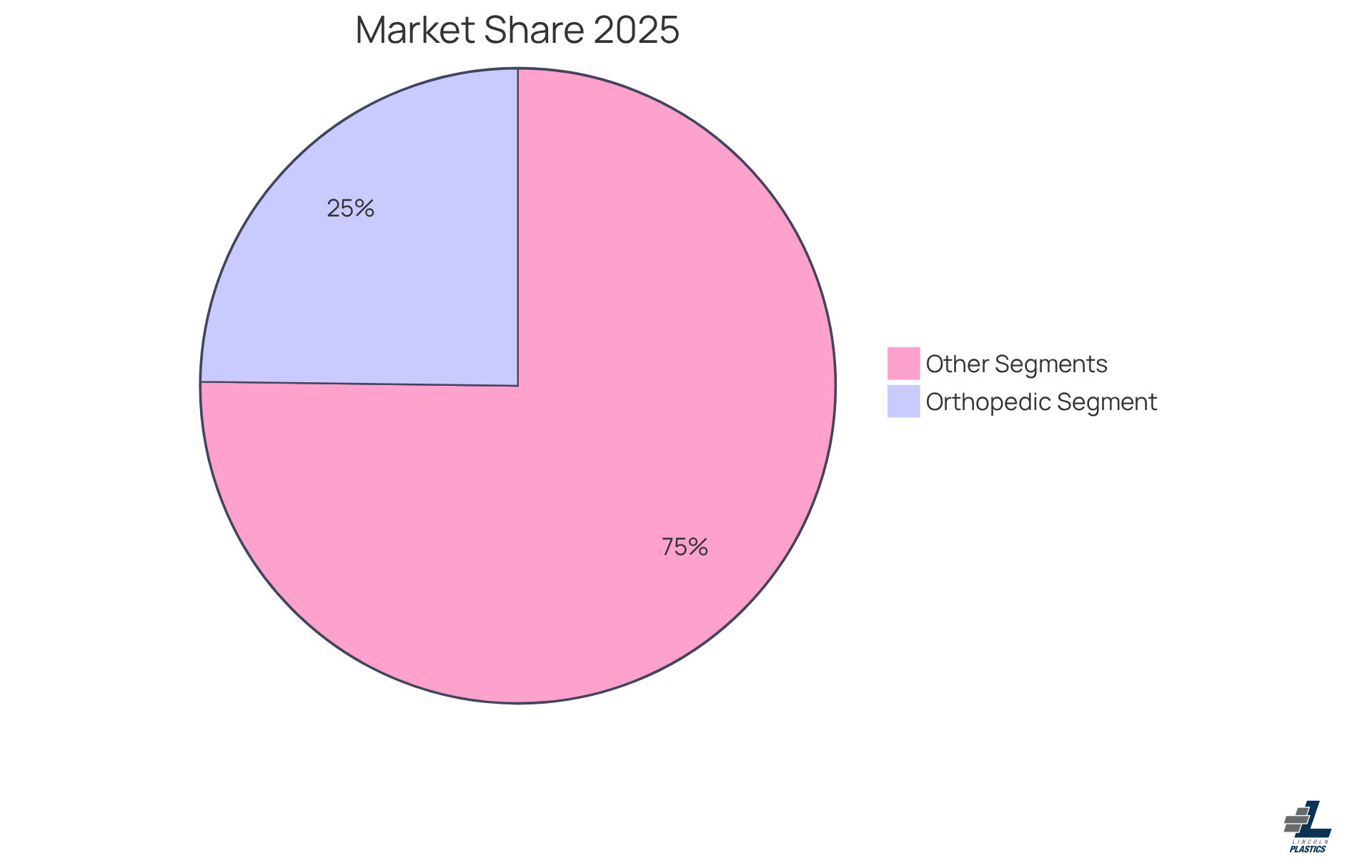
Polycaprolactone (PCL): Flexible Biodegradable Polyester for Diverse Uses
Hey there! Have you ever heard of polycaprolactone, or PCL for short? It’s a pretty cool degradable polyester that’s gaining a lot of attention for its flexibility and biocompatibility. You’ll find it popping up in all sorts of places, from medical devices to eco-friendly packaging. What makes PCL stand out is its ability to be shaped into different forms, like films, fibers, and even scaffolds for tissue engineering. Plus, it breaks down in both aerobic and anaerobic environments, making it a fantastic choice for sustainable practices across various industries.
Now, let’s talk about its role in the medical field. PCL is becoming a go-to material for bioresorbable sutures, tissue scaffolds, and drug delivery systems. Why? Because it works well with human tissues and has a slow degradation rate. This means it can support healing without needing to be surgically removed later on. Isn’t that neat? Companies like Corbion and Ingevity are leading the charge with innovative products that cater to the pharmaceutical industry’s needs.
But wait, there’s more! PCL isn’t just for medical uses; it’s also considered one of the examples of biodegradable plastics in packaging. Its unique properties help create examples of biodegradable plastics, including compostable films and containers that meet strict environmental regulations. The market for PCL is expected to grow significantly, with estimates suggesting it could be worth around USD 580.1 million by 2025 and USD 1,088.7 million by 2032. That’s a lot of eco-friendly products!
And speaking of innovation, have you heard about Amerigo Scientific’s new 3D electrospun PCL scaffolds? They’re enhancing 3D cell culture processes, showcasing just how versatile PCL can be in research and medical applications. However, it’s not all smooth sailing. The PCL market does face some challenges, like competition from alternatives such as polylactic acid and fluctuating raw material prices.
As more industry leaders recognize the benefits of PCL in promoting sustainability, its role in shaping a greener future is becoming increasingly important. So, what do you think? Incorporating insights from experts can really highlight how crucial PCL is in sustainable practices. Let’s keep the conversation going!
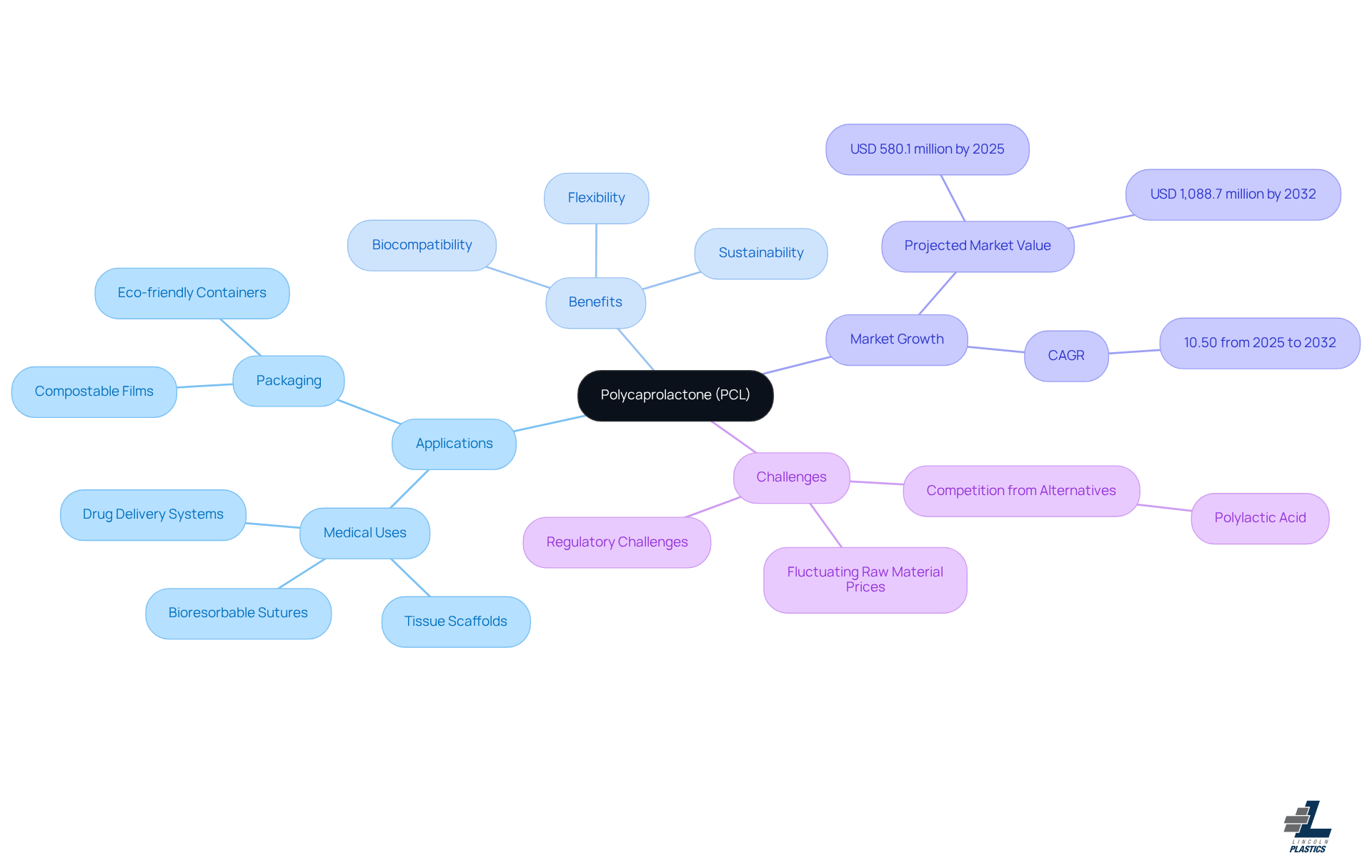
Evolving Regulations and Standards: Shaping the Future of Biodegradable Plastics
You know, the world of compostable materials is really changing fast! With new regulations and standards popping up, there’s a big push for sustainability. Governments and organizations are stepping up, making sure that compostable materials meet strict criteria for compostability and environmental safety. This is super important for building trust with consumers and getting examples of biodegradable plastics into more hands across different sectors.
Take companies like NatureWorks LLC and BASF SE, for example. They’re not just sitting back; they’re actively tweaking their product lines to meet these new standards. It’s all about making sure their offerings align with what’s expected in the market. As we look ahead, it’s crucial for both manufacturers and consumers to stay on top of these changes. Why? Because they’re going to shape the industry’s path through 2025 and beyond. So, let’s keep an eye on this exciting evolution together!

Conclusion
Exploring biodegradable plastics is like stepping into a new world of sustainable solutions that can really make a difference for our planet. By using materials like polyhydroxyalkanoates (PHAs), polylactic acid (PLA), and starch blends, industries can shift away from traditional plastics to eco-friendly options that break down naturally and support a circular economy.
Now, let’s talk about some key insights. The demand for biodegradable plastics is growing across various applications, from packaging to medical devices. Innovations in materials like cellulose-based plastics and biodegradable conducting polymers are paving the way for sustainable practices. Plus, home compostable plastics are making it easier for everyday consumers to do their part. But, there are still challenges to tackle, like production costs, regulatory compliance, and the need for consumer education. These are crucial factors that can affect how widely these materials are adopted.
As the biodegradable plastics market evolves, it’s super important for both businesses and consumers to stay in the loop about advancements and regulations shaping this industry. By making conscious choices and supporting sustainable practices, we can all contribute to a greener future. It’s not just a trend; it’s an imperative that calls for collective action and commitment. So, what do you say? Let’s join forces and make a positive impact together!
Frequently Asked Questions
What is Lincoln Plastics known for?
Lincoln Plastics specializes in custom profile extrusion, focusing on innovative solutions that include biodegradable plastics.
What materials does Lincoln Plastics use for custom profile extrusions?
Lincoln Plastics uses materials such as polyethylene, ridged PVC, flexible PVC, and polypropylene for their custom profile extrusions.
What types of applications can the biodegradable plastics from Lincoln Plastics be used for?
The biodegradable plastics can be used for various applications, including packaging and agricultural uses.
What manufacturing solutions does Lincoln Plastics offer?
Lincoln Plastics offers adaptable manufacturing solutions, including co-extrusion of various colors and the production of both standard and custom round profiles.
What are polyhydroxyalkanoates (PHAs)?
PHAs are biodegradable plastics produced from microbial fermentation of sugars or lipids, known for their versatility and natural breakdown properties.
In what applications are PHAs commonly found?
PHAs are used in eco-friendly packaging and essential medical devices, among other applications.
What recent advancements have been made in the PHA sector?
Recent advancements include a $7 million grant from the U.S. National Science Foundation for developing durable bioplastics and the creation of compostable films that mimic traditional materials.
What challenges does the PHA market face?
The PHA market faces challenges such as limited production capacity, which could slow down growth.
What is Polylactic Acid (PLA) and why is it significant?
PLA is a compostable polymer made from renewable resources like corn starch or sugarcane, significant for its excellent mechanical properties and use in various packaging forms.
How does PLA break down and why is it considered sustainable?
PLA breaks down in industrial composting facilities, making it a sustainable alternative to traditional materials and contributing to a greener future in packaging.
List of Sources
- Lincoln Plastics: Custom Extrusion Solutions for Biodegradable Plastics
- Biodegradable Plastic Market Size to Hit USD 19.41 Billion by 2034 (https://precedenceresearch.com/biodegradable-plastic-market)
- The Extrusion Industry in 2025: Innovations, Trends, and Opportunities (https://plextrusions.com/extrusion-blog/the-extrusion-industry-in-2025-innovations-trends-and-opportunities)
- Spray-coated bioplastics offer scalable, sustainable alternative to plastic packaging (https://news.vt.edu/articles/2025/10/cnre-research-spray-coatings.html)
- Biodegradable Plastics Market Worth USD 88.71 Bn by 2034 (https://globenewswire.com/news-release/2025/09/18/3152553/0/en/Biodegradable-Plastics-Market-Worth-USD-88-71-Bn-by-2034.html)
- Biodegradable Plastics Market Driven by 20.96% CAGR (https://towardspackaging.com/insights/biodegradable-plastics-market-sizing)
- Polyhydroxyalkanoates (PHAs): Versatile Biodegradable Plastics for Various Applications
- Scientists create biodegradable plastic stronger than PET (https://sciencedaily.com/releases/2025/09/250904014137.htm)
- The global Polyhydroxyalkanoate (PHA) market size is USD 72.7 billion in 2024 and will expand at the compound annual growth rate (CAGR) of 11.3% from the year 2024 to 2031. (https://cognitivemarketresearch.com/polyhydroxyalkanoate-pha-market-report)
- Researchers leverage advanced bioengineering techniques to develop plastics made from sustainable biomaterials (https://purdue.edu/newsroom/2025/Q3/researchers-leverage-advanced-bioengineering-techniques-to-develop-plastics-made-from-sustainable-biomaterials)
- Scientists create natural plastics for everyday packaging (https://phys.org/news/2025-10-scientists-natural-plastics-everyday-packaging.html)
- Researchers turn food waste into biodegradable plastic - Binghamton News (https://binghamton.edu/news/story/5671/binghamton-university-researchers-develop-process-to-turn-food-waste-into-biodegradable-plastic)
- Polylactic Acid (PLA): A Leading Biodegradable Plastic in Packaging
- Inside the debate over PLA, the packaging industry’s favorite bioplastic (https://packagingdive.com/news/polylactic-acid-pla-bioplastic-compostable-packaging/728875)
- Polylactic Acid Market worth $4.51 billion by 2030, at a CAGR of 17.5%, says MarketsandMarkets™ (https://globenewswire.com/news-release/2025/09/25/3155942/0/en/Polylactic-Acid-Market-worth-4-51-billion-by-2030-at-a-CAGR-of-17-5-says-MarketsandMarkets.html)
- Polylactic Acid (PLA): The Future of Bioplastic Packaging (https://hanoiplasticbag.com/en/plastic-industry-news/what-is-pla-polylactic-acid)
- Why PLA is a scalable solution to tackle plastics pollution (https://weforum.org/stories/2025/08/pla-scalable-solution-plastics-pollution)
- Polylactic Acid (PLA) Market Size to Surpass USD 3,864.79 Million by 2034 Amid Rising Demand for Sustainable Packaging (https://finance.yahoo.com/news/polylactic-acid-pla-market-size-082000842.html)
- Starch Blends: Sustainable Biodegradable Plastics from Renewable Resources
- 2025 Starch Blends Biodegradable Plastic Market Outlook: Key Indicators Shaping Growth Through 2034 (https://openpr.com/news/4254014/2025-starch-blends-biodegradable-plastic-market-outlook-key)
- Starch Blended Biodegradable Polymer Analysis 2025 and Forecasts 2033: Unveiling Growth Opportunities (https://archivemarketresearch.com/reports/starch-blended-biodegradable-polymer-389139)
- U.S. Biodegradable Plastics Market Size to Hit USD 5.27 Billion by 2034 (https://towardschemandmaterials.com/insights/us-biodegradable-plastics-market)
- Bioplastic Technology and Market Growth in 2025 and Beyond - Niir Project Consultancy Services (https://niir.org/blog/plant-based-plastic-production)
- Cellulose-Based Plastics: Eco-Friendly Alternatives in Biodegradable Solutions
- U.S. Cellulose Plastics Market Set for Dynamic Development with Key Players BASF, DuPont, Eastman, and Tredegar (https://openpr.com/news/4217157/u-s-cellulose-plastics-market-set-for-dynamic-development-with)
- Bioengineered Cellulose Offers a New Route Beyond Plastic - ASME (https://asme.org/Topics-Resources/Content/Bioengineered-Cellulose-Offers-a-New-Route-Beyond-Plastic)
- Cellulose Bioplastics: The Choice of Leading Companies (https://plasticsengineering.org/2025/03/cellulose-bioplastics-the-choice-of-leading-companies-008068)
- Extra-Strong Bacterial Cellulose Sheets as a Biodegradable Alternative to Plastic (https://technologynetworks.com/applied-sciences/news/extra-strong-bacterial-cellulose-sheets-as-a-biodegradable-alternative-to-plastic-402532)
- Cellulose-based Plastic in North America: Market Dynamics and Forecasts 2025-2033 (https://marketreportanalytics.com/reports/cellulose-based-plastic-29296)
- Oxo-Degradable Plastics: Accelerated Breakdown for Improved Waste Management
- New plastic regulations will keep more plastic waste out of communities (https://news.gov.bc.ca/releases/2024ENV0033-001092)
-
- Disappearing plastic? The controversy of oxo-degradable (https://talkingrubbishpodcast.com/28-disappearing-plastic-the-controversy-of-oxo-degradable)
- Oxo-degradable plastics: Study highlights biodegradability and sustainability limits (https://packaginginsights.com/news/soil-health-warning-oxo-degradable-plastic.html)
- Breaking News! Ireland Bans Oxo-degradable Plastics - Line News - News (https://chinabiomaterial.com/news/breaking-news-ireland-bans-oxo-degradable-pla-85272922.html)
- Ellen MacArthur Foundation calls to ban oxo-degradable plastic packaging worldwide. - BSIbio (https://bsibio.com/ellen-macarthur-foundation-calls-to-ban-oxo-degradable-plastic-packaging-worldwide)
- Home Compostable Plastics: Convenient Solutions for Sustainable Waste Management
- Ahlstrom introduces a brand-new home compostable coffee pod portfolio, GreenPod Home (https://ahlstrom.com/Media/releases/press-releases2/2025/ahlstrom-introduces-a-brand-new-home-compostable-coffee-pod-portfolio-greenpod-home)
- BPI introduces home compostable certification, label (https://packagingdive.com/news/bpi-biodegradable-products-home-compostable-certification-label/760465)
- Ahlstrom Launches Home-Compostable Coffee Capsule Line with New GreenPod Home Technology (https://netzerocompare.com/articles/ahlstrom-launches-home-compostable-coffee-capsule-line-with-new-greenpod-home-technology)
- Compostable Packaging Market Forecast, 2025-2032 (https://coherentmarketinsights.com/industry-reports/compostable-packaging-market)
- Biodegradable Conducting Polymers: Innovations in Medical Applications
- Biodegradable ‘heat bombs’ safely target specific cells | Cornell Chronicle (https://news.cornell.edu/stories/2025/06/biodegradable-heat-bombs-safely-target-specific-cells)
- Advanced Biodegradable Polymers for Medical Devices | Technology Transfer (https://techtransfer.nih.gov/tech/tab-5079)
- Biodegradable Conductive Polymers Market Trends & Forecast (https://transparencymarketresearch.com/biodegradable-conductive-polymers-market.html)
- Press Release - USD Analytics (https://usdanalytics.com/press-release/global-biodegradable-medical-plastics-market)
- Biodegradable Polymers Market Size & Share Report, 2025-2034 (https://gminsights.com/industry-analysis/biodegradable-polymers-market)
- Polycaprolactone (PCL): Flexible Biodegradable Polyester for Diverse Uses
- Polycaprolactone Market Size and YoY Growth Rate, 2025-2032 (https://coherentmarketinsights.com/market-insight/polycaprolactone-market-3553)
- Polycaprolactone Market Size And Share Report, 2033 (https://straitsresearch.com/report/polycaprolactone-market)
- Polycaprolactone (PCL) Market Size & Share | Industry Growth 2032 (https://databridgemarketresearch.com/reports/global-polycaprolactone-pcl-market?srsltid=AfmBOoptJUABcvSL6ZbUrpjRkLWiXgXvv2WuPjRQyA1IlEWux6kDgeYS)
- Polycaprolactone Market Value to Hit USD 1,391 Mn | CAGR 9.5% (https://news.market.us/polycaprolactone-market-news)
- Evolving Regulations and Standards: Shaping the Future of Biodegradable Plastics
- Biodegradable Food Packaging 2025–2030: Materials, Manufacturing Hubs, Demand Hotspots, and the Playbook for Global Scale - Sustainable Business Magazine (https://sustainablebusinessmagazine.net/eco-review/biodegradable-food-packaging-2025-2030-materials-manufacturing-hubs-demand-hotspots-and-the-playbook-for-global-scale)
- Biodegradable Plastic Market Size And Share Report, 2030 (https://grandviewresearch.com/industry-analysis/biodegradable-plastics-market)
- The State of the Biodegradable Plastics Industry: Growth, Innovation, and the Road Ahead (https://goecopure.com/the-state-of-the-biodegradable-plastics-industry)
- Packaging laws taking effect in 2025 (https://packagingdive.com/news/packaging-laws-2025-plastics-foam-hotels-epr/736207)
- Biodegradable Plastics Market Size, Industry Share Growth Forecast, Global Trends Report, [Latest] (https://marketsandmarkets.com/Market-Reports/biodegradable-plastics-93.html)


